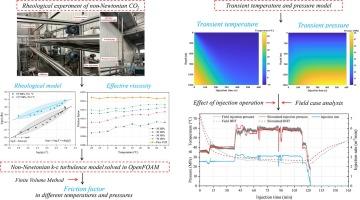Flow and heat transfer for non-Newtonian CO2 mixed fluid injection in the wellbore
IF 6.7
1区 工程技术
Q2 ENERGY & FUELS
引用次数: 0
Abstract
CCUS (Carbon capture, utilization, and storage) is a crucial approach to addressing the climate crisis caused by fossil fuels. CO2 (carbon dioxide) injection is a vital process in both geological CO2 geological sequestration and utilization. Understanding the flow and heat transfer during CO2 injection is essential for the technological design and analysis of CO2 behavior in geological formations. Although the flow and heat transfer of pure CO2 have been extensively studied, the complex non-Newtonian properties of fluids caused by the interaction of CO2 with the additives remain underexplored. This study developed a rheological model of non-Newtonian CO2 mixed fluid by performing experiments at various temperatures and pressures. The friction factor and flow mechanisms of non-Newtonian CO2 mixed fluid were then analyzed using the finite volume method. Finally, the transient temperature and pressure during different injection operations were numerically simulated. The findings indicate that non-Newtonian CO2 mixed fluid exhibits shear-thinning properties, which intensify under high temperatures and pressures. The frictional resistance to the flow of non-Newtonian CO2 mixed fluid is reduced due to a slippage effect that creates a more uniform velocity profile. The field injection case demonstrates that our model can accurately predict the variations and magnitudes of pressure and temperature. Optimizing the injection rate, duration, and shutdown time proved feasible for managing BHT (bottomhole temperature), which provides insights for optimizing injection design and CO2 utilization efficiency.

井筒中注入非牛顿二氧化碳混合流体的流动和传热
CCUS(碳捕集、利用和封存)是解决化石燃料造成的气候危机的重要方法。CO2(二氧化碳)注入是二氧化碳地质封存和利用的重要过程。了解二氧化碳注入过程中的流动和传热对于技术设计和分析二氧化碳在地质构造中的行为至关重要。尽管对纯 CO2 的流动和传热进行了广泛研究,但对 CO2 与添加剂相互作用所导致的流体复杂的非牛顿特性仍未进行深入探讨。本研究通过在不同温度和压力下进行实验,建立了非牛顿二氧化碳混合流体的流变学模型。然后使用有限体积法分析了非牛顿型二氧化碳混合流体的摩擦因数和流动机制。最后,对不同注入操作过程中的瞬态温度和压力进行了数值模拟。研究结果表明,非牛顿二氧化碳混合流体具有剪切稀化特性,这种特性在高温高压条件下会加剧。非牛顿二氧化碳混合流体的流动摩擦阻力由于滑动效应而减小,从而产生了更均匀的速度曲线。现场注入案例表明,我们的模型可以准确预测压力和温度的变化及幅度。事实证明,优化注入速度、持续时间和关闭时间对管理 BHT(井底温度)是可行的,这为优化注入设计和二氧化碳利用效率提供了启示。
本文章由计算机程序翻译,如有差异,请以英文原文为准。
求助全文
约1分钟内获得全文
求助全文
来源期刊

Fuel
工程技术-工程:化工
CiteScore
12.80
自引率
20.30%
发文量
3506
审稿时长
64 days
期刊介绍:
The exploration of energy sources remains a critical matter of study. For the past nine decades, fuel has consistently held the forefront in primary research efforts within the field of energy science. This area of investigation encompasses a wide range of subjects, with a particular emphasis on emerging concerns like environmental factors and pollution.
 求助内容:
求助内容: 应助结果提醒方式:
应助结果提醒方式:


